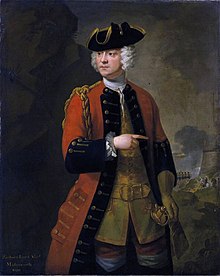Richard Molesworth, 3rd Viscount Molesworth
The Viscount Molesworth | |
|---|---|
 Richard Molesworth, 3rd Viscount Molesworth | |
| Born | 1680 Swords, Dublin |
| Died | 12 October 1758 (aged 77 or 78) London, England |
| Buried | Kensington,London |
| Allegiance | |
| Service/ | |
| Years of service | 1702–1758 |
| Rank | Field Marshal |
| Commands | Commander-in-Chief,Ireland |
| Battles/wars | War of the Spanish Succession Jacobite rising of 1715 |
Field MarshalRichard Molesworth, 3rd Viscount Molesworth,PC (Ire)FRS(1680 – 12 October 1758), styled The Honourable Richard Molesworth from 1716 to 1726, was an Anglo-Irish military officer, politician and nobleman. He served with his regiment at theBattle of Blenheimbefore being appointedaide-de-campto theDuke of Marlboroughduring theWar of the Spanish Succession.During theBattle of RamilliesMolesworth offered Marlborough his own horse after Marlborough fell from thesaddle.Molesworth then recovered his commander's charger and slipped away: by these actions he saved Marlborough's life. Molesworth went onLieutenant of the Ordnance in Irelandand was wounded at theBattle of Prestonduring theJacobite rising of 1715before becomingMaster-General of the Ordnance in Irelandand thenCommander-in-Chiefof theRoyal Irish Army.
Military career
[edit]Born the younger son ofRobert Molesworth, 1st Viscount Molesworthand Letitia Molesworth (née Coote, daughter ofRichard Coote, Lord Coloony), Molesworth abandoned his legal studies and wascommissionedas anensigninOrkney's Regimenton 14 April 1702.[1]
Promoted tocaptain,Molesworth served with his regiment at theBattle of Blenheimin August 1704, before being appointedaide-de-campto theDuke of Marlboroughon 22 May 1706 during theWar of the Spanish Succession.[2]During theBattle of Ramillies,which took place the following day, Molesworth offered Marlborough his own horse after Marlborough fell from thesaddle.[2]Molesworth then recovered his master's charger and slipped away: by these actions he saved his master's life.[2]Promoted to captain in theColdstream Guardsandlieutenant colonelin the Army on 5 May 1707, he was present at the relief ofBrusselsin 1708 and at theBattle of Malplaquetin September 1709 and was wounded by a mine at theSiege of Monsin October 1709.[2]He commanded an infantry regiment inCataloniaunder theDuke of Argyllfrom July 1710 until he returned to England in late 1712.[2]
Molesworth becameLieutenant of the Ordnance in Irelandin December 1714 and was elected Member of Parliament in theIrish House of CommonsforSwordsin 1715.[2]He raised a regiment of Dragoons in 1715 and was wounded at theBattle of Prestonin November 1715 during theJacobite risingof that year.[2]After taking part in the competition to develop amarine chronometer,he was elected aFellow of the Royal Societyin March 1722.[3]
Molesworth becamecolonelof theInniskilling Regiment of Footin March 1725 and succeeded his brother as 3rd Viscount Molesworth on 17 February 1726.[4]He went on to be colonel of theViscount Molesworth's Regiment of Dragoonsin May 1732 and, having been promoted tomajor-generalon 18 December 1735[5]and appointed aLord Justice for Irelandin December 1736, he became colonel of the5th Regiment of Dragoonsin June 1737.[6]Promoted to the local rank oflieutenant-generalin Ireland in 1739, he becameMaster-General of the Ordnance in Irelandin 1740.[4]Promoted to the substantive rank of lieutenant-general on 1 July 1742 and to general of the horse on 24 March 1746,[7]he becameCommander-in-Chief,Ireland in September 1751.[4]At this time he lived at14 Henrietta StreetinDublin.[8]
Promoted tofield marshalon 3 December 1757,[9]Molesworth became Governor of theRoyal Hospital Kilmainham;he died in London on 12 October 1758 and was buried inKensington.[4]He was succeeded in the title by his only son Richard. Lady Molesworth died in a house fire in 1763 with two of her daughters.[10]

14 Henrietta Street,Dublin,August 2011
Family
[edit]Molesworth first married Jane Lucas, of whose family little is known; they had three children, Amelia, Letitia, and Mary, who became the second wife ofRobert Rochfort, 1st Earl of Belvedere,and suffered greatly from his ill-treatment of her, which became a subject of public comment.[11]Following the death of his first wife he married Mary Jenney Ussher, daughter of the Reverend William Ussher,Archdeacon of Clonfert,and his wife Mary Jenney, on 7 February 1744 and had seven children from this union: Richard, 4th Viscount Molesworth, Henrietta (who married Right Hon.John Staples,MP forAntrim), Elizabeth, Charlotte, Melosina, Mary and Louisa (who married firstlyWilliam Ponsonby, 1st Baron Ponsonby,and secondlyWilliam Fitzwilliam, 4th Earl Fitzwilliam).[12]Mary and Melosina perished along with their mother in a house fire in 1763.[10]
References
[edit]- ^"Richard Molesworth, 3rd Viscount Molesworth".Oxford Dictionary of National Biography.Retrieved20 July2014.
- ^abcdefgHeathcote, p. 211
- ^"Library and Archive Catalogue"(PDF).Royal Society.Retrieved20 July2014.
- ^abcdHeathcote, p. 212
- ^"No. 7464".The London Gazette.16 December 1735. p. 1.
- ^"No. 7614".The London Gazette.28 June 1737. p. 2.a.
- ^"No. 8625".The London Gazette.21 March 1746. p. 2.
- ^"Henrietta Street Conservation Plan"(PDF).Dublin City Council. p. 17.Retrieved20 July2014.
- ^"No. 9744".The London Gazette.29 November 1757. p. 1.
- ^abLenox-Conyngham, Mina (2005).Springhill: An Old Ulster House and the People who Lived in it.Ulster Historical Foundation.ISBN978-1903688380.Retrieved15 January2018.
- ^Cokayne, G.E. (2000).The Complete Peerage of England, Scotland, Ireland, Great Britain and the United Kingdom, Extant, Extinct or Dormant, new ed., volume II.Alan Sutton Publishing. p. 114.
- ^Cokayne, G.E. (2000).The Complete Peerage of England, Scotland, Ireland, Great Britain and the United Kingdom, Extant, Extinct or Dormant, new ed., volume X.Alan Sutton Publishing. p. 576.
Sources
[edit]- Heathcote, Tony (1999).The British Field Marshals 1736–1997.Pen & Sword Books Ltd.ISBN0-85052-696-5.
- 1680 births
- 1758 deaths
- Members of the Middle Temple
- 5th Royal Irish Lancers officers
- 9th Queen's Royal Lancers officers
- British field marshals
- Irish MPs 1715–1727
- Members of the Parliament of Ireland (pre-1801) for County Dublin constituencies
- Members of the Privy Council of Ireland
- Royal Scots officers
- Viscounts in the Peerage of Ireland
- Fellows of the Royal Society
- Coldstream Guards officers
- Younger sons of viscounts
